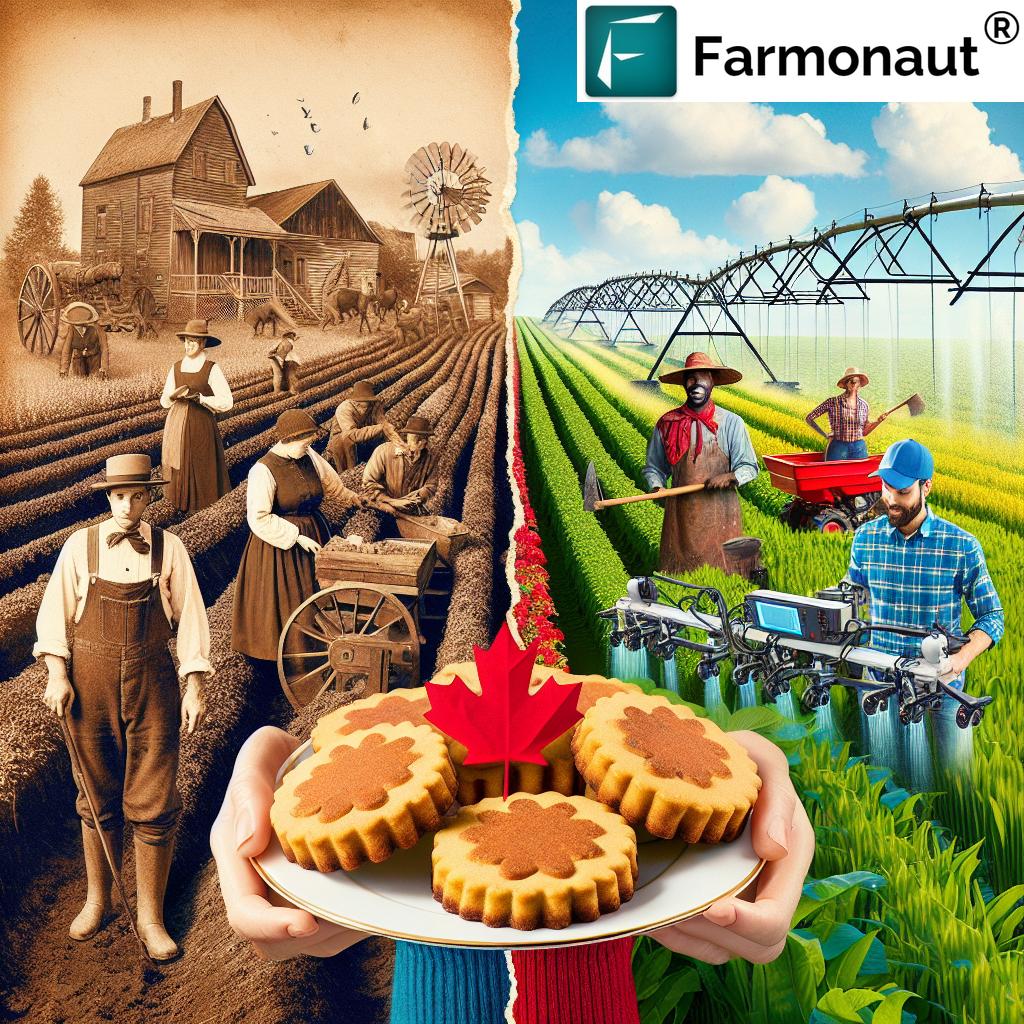Discover Canadian Culinary History: Bake Confederation Tea Cakes from 1867
“The Confederation Tea Cakes recipe dates back to 1867, the same year Canada became a nation.”
Welcome, fellow food enthusiasts and history buffs! Today, we’re embarking on a delightful journey through time to explore a treasured piece of Canadian culinary heritage. Get ready to don your aprons and fire up your ovens as we delve into the fascinating world of Confederation Tea Cakes, a delicious snapshot of Canada’s rich agricultural and culinary past.
At Farmonaut, we’re not just about cutting-edge agricultural technology; we’re also passionate about connecting the dots between our farming roots and the innovative techniques of today. So, let’s roll up our sleeves and discover how a simple tea cake recipe can teach us volumes about Canadian agriculture history, sustainable farming practices, and the evolution of our nation’s food culture.
A Taste of History: Unearthing the 1867 Cookbook
Picture this: it’s 1867, and Canada is taking its first steps as a newly formed nation. In kitchens across the land, housewives are thumbing through a rare cookbook, its pages filled with recipes that reflect the flavors and ingredients of the time. Among these culinary treasures is our star of the day – the Confederation Tea Cake.
This recipe is more than just a list of ingredients; it’s a window into the past, offering us insights into the crop cultivation techniques and agricultural research in Canada of that era. As we explore this recipe, we’ll uncover the challenges faced by farmers and home cooks alike, and how they made the most of the resources available to them.

The Recipe: Simplicity Meets Flavor
“These historical tea cakes use just 4 main ingredients: flour, butter, sugar, and currants.”
The beauty of Confederation Tea Cakes lies in their simplicity. With just a handful of ingredients – flour, butter, sugar, and currants – our ancestors created a treat that has stood the test of time. Let’s break down these ingredients and see what they tell us about Canadian agriculture history:
- Flour: The backbone of many baked goods, flour production was a crucial aspect of early Canadian farming. Wheat was a staple crop, and the development of hardy wheat varieties suited to our climate was a significant achievement in agricultural research in Canada.
- Butter: Dairy farming played a vital role in early Canadian agriculture. The presence of butter in this recipe speaks to the importance of livestock in the farming landscape of 1867.
- Sugar: While sugar cane wasn’t grown in Canada, the inclusion of sugar in this recipe indicates trade relationships and the beginnings of a globalized food system.
- Currants: These small, tart berries were likely grown in home gardens or small-scale farms, showcasing the diversity of crops cultivated in 19th-century Canada.
From Field to Table: Agricultural Practices of 1867
To truly appreciate these tea cakes, we need to understand the agricultural landscape of 1867. Farming in those days was a labor-intensive affair, relying heavily on manual work and animal power. Let’s explore some of the key aspects of farming during this period:
- Soil Management: Early Canadian farmers practiced crop rotation and used natural fertilizers like manure to maintain soil health. These sustainable farming practices were crucial for ensuring continued productivity.
- Crop Diversity: Farmers grew a variety of crops to ensure food security and soil health. This diversity is reflected in the ingredients of our tea cakes.
- Manual Labor: From plowing fields to harvesting crops, much of the work was done by hand or with the help of livestock. The tools and equipment of the time were simple but effective.
- Water Management: Efficient irrigation was crucial. Farmers relied on natural water sources and developed ingenious ways to manage water distribution.
As we reflect on these practices, it’s fascinating to see how modern farming methods have evolved while still building on the wisdom of the past. At Farmonaut, we’re proud to be part of this ongoing agricultural evolution, offering precision agriculture technology that helps today’s farmers make data-driven decisions for optimal crop health and yield.
Adapting Historical Recipes for Modern Kitchens
Now, let’s roll up our sleeves and bring this piece of history to life in our modern kitchens. Adapting historical recipes can be a bit of a culinary adventure, but that’s part of the fun! Here’s how we can recreate these delightful tea cakes while honoring their heritage:
| Ingredient | 1867 Measurement | Modern Equivalent | Historical Farming Method | Modern Sustainable Practice |
|---|---|---|---|---|
| Flour | 1 teacup | 240ml | Hand-sown wheat fields | Precision seeding with GPS guidance |
| Butter | 1 egg-sized lump | 60g | Hand-churned from family cow | Sustainable dairy farming with methane capture |
| Sugar | 2 tablespoonfuls | 30g | Imported and expensive | Local sugar beet production |
| Currants | A handful | 50g | Home garden cultivation | Organic berry farming with drip irrigation |
As we adapt this recipe, we’re not just baking; we’re participating in a hands-on history lesson. Each step connects us to the Canadian farmers and home cooks of the past, while also highlighting the incredible advancements in agricultural research in Canada.
The Art of Historical Baking: Challenges and Triumphs
Recreating historical recipes like the Confederation Tea Cakes comes with its own set of challenges. Here are some tips to help you navigate the world of 19th-century cookery:
- Interpret Vague Instructions: Historical recipes often use terms like “a good-sized lump” or “a hot oven.” Use your best judgment and don’t be afraid to experiment.
- Adjust for Modern Ingredients: Today’s flour may behave differently than the flour of 1867. Be prepared to adjust your liquid ratios.
- Embrace Imperfection: Remember, these cakes were homemade treats, not professional pastries. Celebrate their rustic charm!
- Use Modern Tools Wisely: While our ancestors might not have had electric mixers, there’s no shame in using modern equipment to make the process easier.

From Past to Present: The Evolution of Canadian Agriculture
As we knead our dough and shape our tea cakes, let’s take a moment to reflect on how far Canadian agriculture has come since 1867. The journey from manual farming to today’s high-tech agricultural landscape is nothing short of remarkable.
In the early days of Confederation, farming was a labor-intensive process that relied heavily on human and animal power. Today, precision agriculture technology has revolutionized the way we grow food. At Farmonaut, we’re proud to be at the forefront of this agricultural revolution, offering farmers tools to monitor crop health, manage resources efficiently, and make data-driven decisions.
Let’s look at some key areas where agriculture has evolved:
- Soil Management: While our ancestors relied on crop rotation and natural fertilizers, today’s farmers have access to sophisticated soil testing and management techniques. Farmonaut’s satellite-based crop health monitoring helps farmers understand their soil’s needs with unprecedented precision.
- Water Conservation: From relying on rainfall to implementing advanced irrigation systems, water management has come a long way. Our platform helps farmers optimize water usage by providing real-time data on soil moisture levels.
- Crop Diversity: While early Canadian farmers grew a variety of crops for subsistence, today’s agricultural landscape includes a wide range of specialized crops. Our AI-powered advisory system helps farmers choose the best crops for their specific conditions.
- Farm Equipment: The simple tools of 1867 have given way to high-tech machinery guided by GPS and AI. Farmonaut’s fleet management tools help farmers optimize the use of this modern equipment.
Sustainable Farming: Honoring the Past, Embracing the Future
As we savor our freshly baked Confederation Tea Cakes, let’s consider how the principles of sustainability that guided our ancestors are being reimagined for the 21st century. Sustainable farming practices are more crucial than ever as we face challenges like climate change and resource scarcity.
Here’s how modern agriculture is building on the wisdom of the past:
- Crop Rotation: This age-old practice is still vital for soil health. Today, farmers use sophisticated models to optimize rotation patterns.
- Natural Pest Control: While our ancestors might have used companion planting, today’s farmers have access to advanced integrated pest management techniques.
- Resource Conservation: From renewable energy on farms to precision irrigation, modern agriculture is finding innovative ways to conserve resources.
- Biodiversity: Just as early Canadian farmers understood the importance of diverse crops, today’s sustainable farms are creating habitats for beneficial insects and wildlife.
At Farmonaut, we’re committed to supporting these sustainable practices through our technology. Our platform helps farmers reduce waste, optimize resource use, and make environmentally conscious decisions.
The Legacy of Confederation Tea Cakes
As we wrap up our culinary journey through time, let’s reflect on what these humble tea cakes can teach us about Canadian identity and agricultural heritage. These biscuits are more than just a sweet treat; they’re a tangible link to our past, a testament to the ingenuity and resourcefulness of early Canadian settlers.
By baking and sharing these cakes, we’re not just indulging in a delicious snack; we’re participating in a living history lesson. We’re connecting with the farmers and housewives of the past, understanding their challenges and appreciating their skills.
Moreover, this recipe serves as a reminder of how far we’ve come in terms of agricultural innovation. From the simple tools and techniques of 1867 to the cutting-edge technology offered by companies like Farmonaut, Canadian agriculture has always been at the forefront of innovation.
Embracing Our Culinary Heritage in the Digital Age
As we’ve seen, exploring historical recipes like Confederation Tea Cakes can be a rich and rewarding experience. But how can we continue to celebrate and preserve our culinary heritage in today’s fast-paced, digital world? Here are some ideas:
- Digital Archives: Support initiatives to digitize historical cookbooks and make them accessible online. This preserves valuable information and makes it available to a wider audience.
- Social Media Sharing: Share your experiences baking historical recipes on platforms like Instagram or TikTok. Use hashtags like #CanadianCulinaryHeritage to connect with others who share your passion.
- Virtual Cooking Classes: Organize or participate in online cooking classes focused on historical Canadian recipes. This is a great way to build community and share knowledge.
- Farm-to-Table Connections: Use apps like Farmonaut to connect with local farmers and source ingredients that are as close as possible to what our ancestors would have used.
The Future of Canadian Cuisine: Inspired by the Past, Powered by Innovation
As we look to the future of Canadian cuisine, it’s clear that our rich culinary heritage will continue to play a crucial role. But just as our ancestors adapted to new challenges and opportunities, so too must we embrace innovation in our approach to food and agriculture.
At Farmonaut, we’re excited to be part of this ongoing story. Our technology is helping farmers across North America and beyond to grow food more efficiently and sustainably. By combining the wisdom of traditional farming practices with cutting-edge precision agriculture technology, we’re helping to ensure that future generations will have access to delicious, nutritious food.
Whether you’re a home baker experimenting with historical recipes or a farmer using satellite data to optimize your crop yields, you’re part of a long and proud tradition of Canadian innovation in food and agriculture. So the next time you bite into a Confederation Tea Cake or any other beloved Canadian dish, take a moment to savor not just the flavors, but the rich history and bright future of Canadian cuisine.
FAQ: Confederation Tea Cakes and Canadian Culinary History
Q: Why are these called Confederation Tea Cakes?
A: These tea cakes are named after the Canadian Confederation of 1867, the same year the recipe originated. They represent a significant moment in Canadian history and culinary tradition.
Q: Can I use modern ingredients in this historical recipe?
A: Absolutely! While using ingredients closest to the original can provide an authentic experience, modern equivalents work well too. The key is to maintain the spirit of the recipe.
Q: How do these tea cakes reflect Canadian agriculture of the 1860s?
A: The simple ingredients – flour, butter, sugar, and currants – showcase the staple crops and dairy production of early Canadian farms. They reflect the self-sufficiency and resourcefulness of 19th-century Canadian agriculture.
Q: Are there any modern twists I can add to this recipe?
A: Certainly! You could experiment with adding local Canadian flavors like maple syrup or saskatoon berries. Just remember, the charm of this recipe lies in its simplicity.
Q: How has Canadian farming changed since the 1860s?
A: Canadian farming has evolved dramatically, from manual labor and simple tools to high-tech precision agriculture. Today, farmers use advanced technologies like those offered by Farmonaut to optimize crop yields and manage resources efficiently.
Conclusion: A Taste of History, A Vision for the Future
As we conclude our journey through Canadian culinary history, from the humble Confederation Tea Cakes of 1867 to the high-tech farms of today, we’re reminded of the incredible resilience and innovation that have always characterized Canadian agriculture. These simple tea cakes tell a story of resourcefulness, community, and the deep connection between our land and our food.
At Farmonaut, we’re proud to be part of the ongoing story of Canadian agricultural innovation. Our satellite-based farm management solutions, AI-powered advisory systems, and commitment to sustainable farming practices are helping to write the next chapter in Canada’s rich agricultural history.
So, the next time you’re in the kitchen, why not try your hand at baking some Confederation Tea Cakes? As you mix, knead, and bake, remember that you’re not just creating a delicious treat – you’re participating in a living history lesson, connecting with generations of Canadian farmers and home cooks who came before us.
And as we look to the future, let’s carry forward the spirit of innovation and sustainability that has always been at the heart of Canadian agriculture. Whether you’re a farmer using our advanced technology to monitor your crops, or a home gardener growing your own zucchini, you’re part of this grand tradition.
Here’s to the flavors of our past, the innovations of our present, and the bright future of Canadian agriculture. Happy baking, and bon appétit!
Ready to be part of the future of agriculture? Explore Farmonaut’s innovative solutions:
- Check out our API for developers looking to integrate our satellite and weather data.
- Dive into our API Developer Docs for detailed information on how to use our technology.
Join us in cultivating a sustainable and prosperous future for agriculture!






